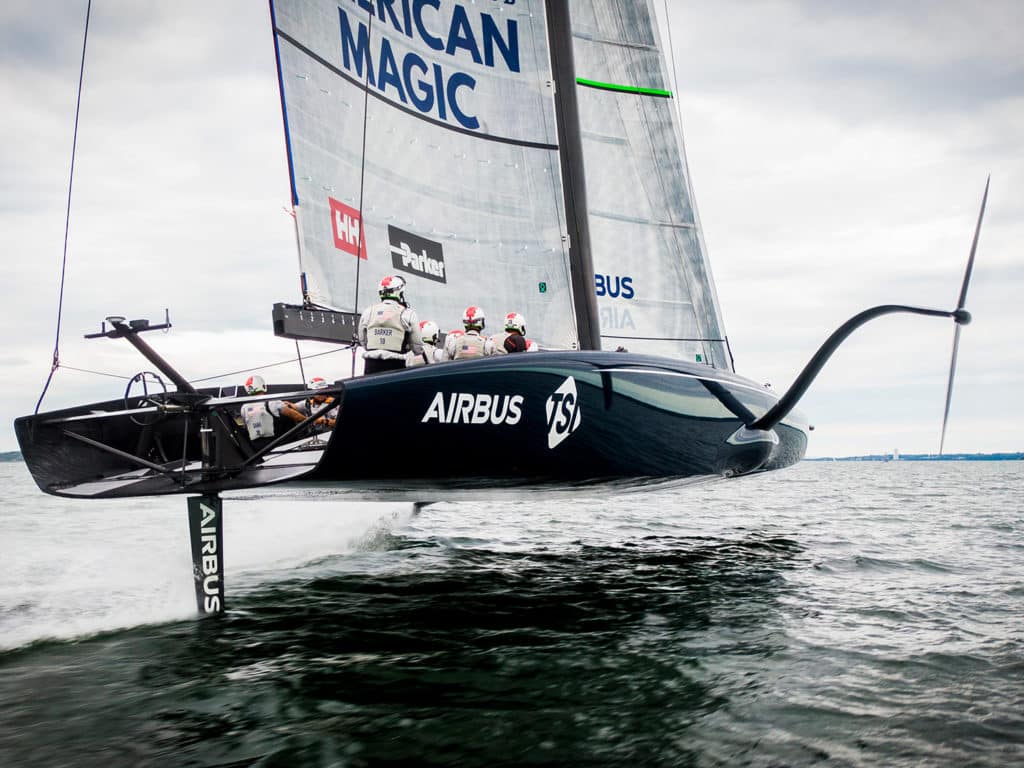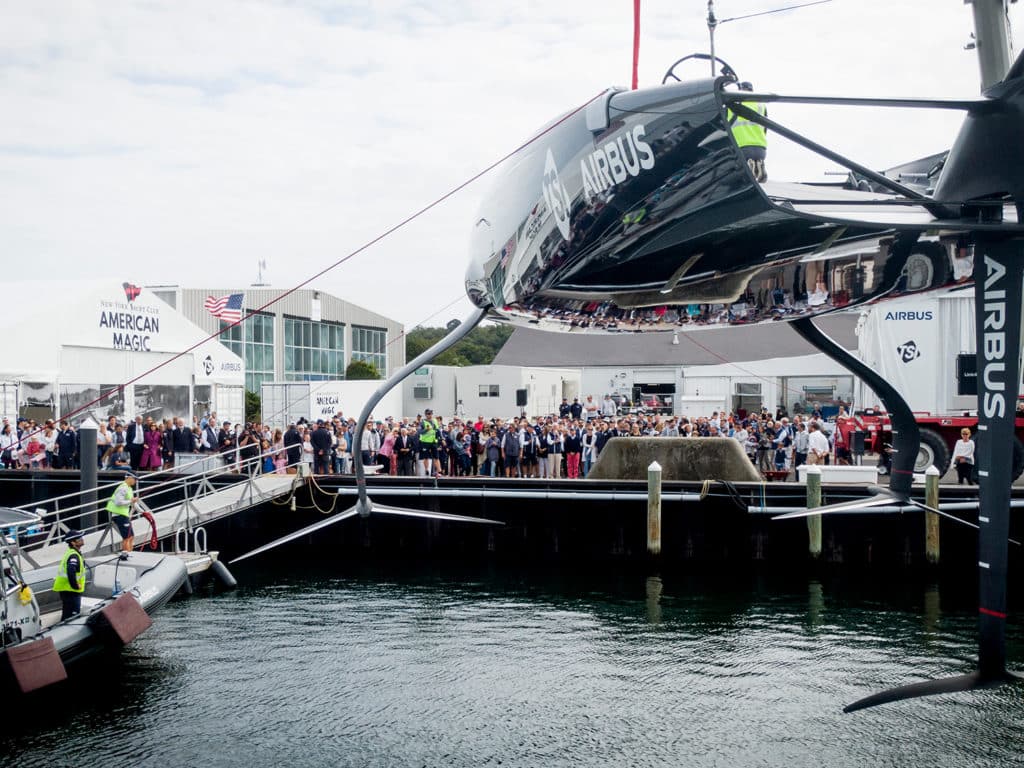
American Magic’s 75-footer sits high in its cradle, on public display for the first time at the team’s base in Portsmouth, Rhode Island, on a crisp and blustery mid-September morning. From certain angles, and especially without its mast stepped, this vessel looks nothing like a sailboat. It’s more akin to a giant fuselage, a scow with a nosecone and an intricate blend of chines and hull rounds that curve around the foil-arm barrels before running straight for the wide, open transom.
As I step back and try to makes sense of its unique lines, I wonder about the deep technical debates that must have waged between the team’s primary designers, Marcelino Botin and Adolfo Carrau, and the Airbus wizards working alongside them. As a sailboat that’s essentially meant to fly, it stands to reason, it should look more like a plane than a yacht.
“It’s ugly when it’s out of the water,” one team member confides, “but it starts to look better once it’s in the water. When it’s sailing, it’s a thing of beauty.”
The parallels to flight are visible throughout the boat: from the complex contours of the foil arms themselves, to the razor-sharp trailing-edge flaps on the foils, and especially the rudder elevator, sculpted with amazing curved precision, into the shape of what looks like an albatross in flight.
It’s not a boat. It’s a three-dimensional work of modern art.
The up-close details of this, American Magic’s first of two boats, can only be described here, for the mandate upon entering the base for the private and confidential christening ceremony is, “No pictures, No video.” Such is the heightened and hyper state of confidentiality as challengers and defender alike reveal their first interpretations of the AC75 Class Rule. The spies are busy around the American Magic compound these days, with INEOS Team UK’s Ben Cornish and a fellow from Luna Rossa Prada Pirelli hovering and shadowing the team’s every move, observing from RIBs and poking cameras through gaps in the base’s privacy fencing to get a closer look.
RELATED: American Magic’s crew explores the new foiling dynamics of the AC75
What spies undoubtedly report back to their bosses is that the New York YC’s AC75 Defiant is indeed unique, and already foiling into maneuvers after only two days on the water. As far as everyone can tell, the American challenger is one, or maybe two, steps ahead of any other syndicate.
And that alone is—perhaps—what has team executive director and skipper Terry Hutchinson choked up and struggling with his speech to more than a 125 teammates, suppliers, partners and yacht club patrons, as well as his mother and family looking on with admiration from the front row.
“I want to take a minute to acknowledge our team,” Hutchinson starts before pausing to take a deep breath and clear what’s welling up in his throat. “Look at what we’ve done. We have constructed a build facility in Rhode Island, we rebuilt the Mule, we launched and tested it in Rhode Island and then Pensacola. We’ve built four foils for the Mule, two masts, constructed and operating system inside the boat that, when on the water, is not distinguished between the Mule and the AC75. We built a D-spar section at Offshore Spars in Detroit, Michigan, for the AC75. We built two foils that are on display here for the AC75, and one rudder and one elevator. We designed and built an AC75 that represents roughly 76,000 manhours.”
Having logged 84 days on the water, Hutchinson says, he can look back on 19 months of high-stakes development and be satisfied with where they’re at: “To think we’d be at this point in the competition, you’d happily take it. But probably most importantly, we’re the first team to foil on an AC75.”
With a short history lesson and words of encouragement that follow from New York YC Commodore William Ketchum, the crane engine roars to life. Strops grow taught as sailors and shore crew take the reins of the 15,000-pound hull as it’s lifted from its cradles and swings out over water for Hutchinson’s mother, Patricia, to lead the official blessing.
With a successful smash of Mumm champagne on the robust carbon prod, the boat is lowered into the water, allowing guests a closer look at the deck and cockpit configuration for the 11 crewmembers that will race the boat. The foredeck is sparse, save for the bowman’s non-skid runway to the prod and the surprisingly small steel ball onto which the D-shaped mast will be stepped. From there, the deck slops down dramatically with a centerline ramp leading to the cockpit. Here, in the “trenches” are four forward-facing pedestals (Emirates Team New Zealand’s are transverse). The forward-most grinders, I’m told, will spend most of their time on their knees.
“That’s the point, confirms grinder and veteran Cup sailor Sean Clarkson. “We can’t see anything, but if we can see anything, then the wind can see us.”

The team’s coach, James Lyne, quantifies it as such: “The lower they can be the better the aero. A person standing up in 20 miles per hour of breeze is 4.5 kilos of drag.”
Following further aft, to starboard, is the stand-up office of dedicated foil trimmer, Andrew Campbell. On a carbon “desk” smaller than a clipboard are various buttons and a video screen that allows him to see what’s happening with the foils below the boat. He’s positioned to starboard at all times.
Behind Campbell is trimmer Paul Goodison’s work station, with a carbon L-shaped leaning post to wedge himself against, a tablet mount and a wired joystick controller to adjust the twin-skinned mainsail’s dynamic and complex systems, as well as the jib sheet. With batteries to control the supplied foil-adjustment system, Goodison has the collective power of all eight grinders.
For American Magic’s towering and lean helmsman, Dean Barker, there’s a leaning pad and a relatively small steering wheel on either side. He has a few buttons on the wheel, as well as custom foot buttons to toe tap. Even with his height, Barker, I’m told, can barely see over the front of the boat. Better visibility comes when the boat is at full tilt, however, because of its bow-down attitude.
During maneuvers, only Barker and Goodison will transfer from side to side. “There isn’t a lot of movement,” says Clarkson, “but that doesn’t mean there’s not a lot going on: you’ve got mast rotation, changing twists, and travelers, outhauls and all that.”
There are plenty of foot buttons alongside the pedestals, which Clarkson says is pretty straightforward. “It’s not complicated at all. You get used to it.”
Clarkson anticipates grinder rotations after what is expected to be 40-minutes races in Auckland, bringing fresh arms into every race. “The more power you have, the faster you’ll go and the more maneuvers you can do,” he says. “Last time, you couldn’t really race the boats like you wanted to because you didn’t have enough oil. This time, we only have to make the energy for the sails.”
In the busy days before Defiant‘s christening, the team reportedly conducted only one day of towing before stepping the rig and going full steam ahead with a high-speed flyby through the New York YC’s Rolex Invitational Cup fleet racing on Narragansett Bay. Spectator cameras and iPhones captured what one sailing team member describes as such: “Compared to the Mule, it’s really stable. Everything is just bigger. You feel the speed for sure. We hit maybe 37 knots and it was just starting to just feel a bit loose. Yeah. It gets going pretty fast.”
Once the invitation-only crowd disperses from the base, sailors and shore crew linger before returning to the day’s work list. There are more six-day work weeks and long days ahead as the team must make hay before packing up the entire operation in November and relocating to its winter training facilities in Pensacola. The next few weeks are critical for decisions to be made for Boat No. 2, which is not far behind in the grand scheme of things. As far as Hutchinson is concerned he’s happy where they’re at, stating as much in his opening remarks.
“When we thought about the name,” he says, “There was really only one word: defiant. It describes us as we go through this, with everyone coming to work with a purpose and a higher meaning to beat the guys that are out there behind us, to beat team new Zealand and to go to work, day in and day out, with a commitment to winning. We are on a great trajectory to bringing the Cup back to the United States.”
If anything, it’s good to be first.









